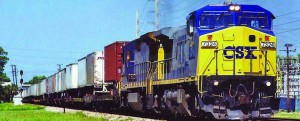Quiet zones may be solution for historic district’s train horns
Posted on December 5, 2012 By Editor Articles, Neighborhood News, Top Stories
 A train’s whistle blowing in the night is nostalgic for some. But for Historic District residents living within earshot, the only nostalgia is for loss of peace and quiet and a good night’s sleep.
A train’s whistle blowing in the night is nostalgic for some. But for Historic District residents living within earshot, the only nostalgia is for loss of peace and quiet and a good night’s sleep.
“Train horns blast throughout the early morning so loudly I warn guests to close their windows at night,” said Tom Merten, co-owner of Riverside’s The Jenks House Bed and Breakfast.
At least 15 CSX trains daily travel the tracks that parallel US-17 and run through the historic districts for about seven miles from Stockton Street to Timuquana Road. Federal Railroad Administration regulations dictate a 2-long-1-short-1-long horn pattern at crossings, which equals many sleepless nights.
To address the problem, Merten and a neighbor, Richard Eckles, have lobbied for “quiet zones,” or rail line sections that contain crossings at which train horns are not routinely sounded. Wayside horns – stationary horns mounted at crossings rather than on trains – are another option. They sound warnings that motorists at crossings hear, but do not carry far beyond. The cost can be $100,000 or more per crossing.
City, state and railroad officials must coordinate in order to institute such solutions. Past District 14 Councilman Michael Corrigan oversaw a 2006 quiet zone study for the area, but said costs prohibited moving forward. Current councilman, Jim Love, said he receives few complaints about the horns but would be willing to investigate if the issue grew momentum. Riverside Avondale Preservation Executive Director Carmen Godwin concurred, noting an economic benefit to residents within quiet zones.
“Some of the properties along the tracks move toward commercial uses instead of residential because of proximity. We’d rather not see more commercial intrusion into residential areas, so silencing the trains in a way that still provides the safety necessary would benefit residential property values,” she said.
Richard Eckles last investigated quiet zones around 2009. Although frustrated by lack of progress from city officials, he said he might try again.
“It’s dormant but simmering in my brain, usually about 3 to 5 a.m. when I’m awakened.”
Contact Richard Eckles:
[email protected]
Contact Jim Love: [email protected] or 904-630-1390
Quiet zones/wayside horns: http://www.quietzonetech.com/
By Steve DiMattia
Resident Community News




 (1 votes, average: 5.00 out of 5)
(1 votes, average: 5.00 out of 5)




